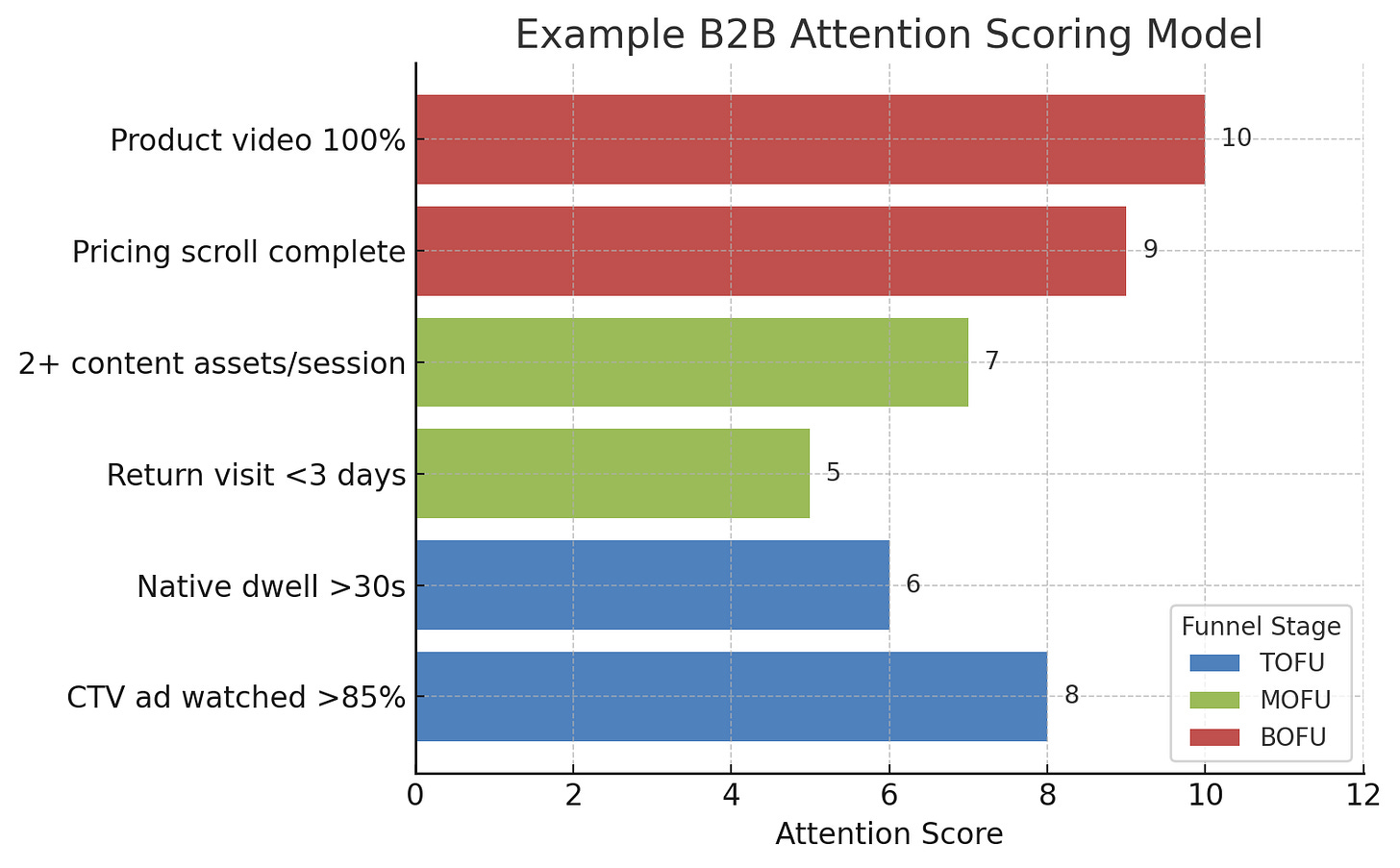Attention as a Buying Signal: The Metric No One Is Scoring
CTR is dead. Attention isn’t just a buzzword — it’s your most underrated buying signal.
We’ve Been Measuring the Wrong Things
CTR, time on site, lead volume — they give the illusion of insight, but miss the signals that actually predict buying behavior. In a post-cookie, multi-device, privacy-constrained world, the most valuable signal you can track isn’t a click.
It’s attention — and almost no one is scoring it properly.
In a post-cookie, multi-device, privacy-constrained world, the most valuable signal you can track isn’t a click.
It’s attention — and almost no one is scoring it properly.
Let’s fix that.
What Is Attention in B2B?
Forget vanity metrics like "scroll depth" or "CTR." In B2B, attention is about mental presence and buyer progression, not surface-level interactions.
True attention is captured through composite behaviors:
Pre-campaign: Signals that help choose where your ad runs — like eye-tracking studies, publisher JS tags, and third-party audience + placement data to predict high attention inventory.
Mid-flight: Live campaign attention tracking — coverage, ad exposure duration, clutter and prominence of placement, page genre, and format-specific signals (CTV completion rates, native dwell time).
Post-campaign: Account-level attention scores, cost per attention unit, cost per high-intent action, brand lift, brand awareness progression, and attention tied to high-value on-site actions.
Think of attention as the natural successor to viewability. Viewability was binary: “Was it in view for 1 second?” Attention is composite: thousands of micro-signals fused into one score — more like a credit rating for your campaign.
When optimised, it delivers a true omnichannel lens for measuring and moving budget — across channels, formats, and devices — based on what’s genuinely driving curiosity, interest, and intent.s.
Who Measures Attention Today?
Several major adtech players already track attention, but each does it differently — often in silos:
Adelaide — AU Score: composite performance measure akin to a credit score for ad placements.
Lumen — Eye-tracking-based attention seconds.
Amplified Intelligence — Measures actual gaze data to model attention probability.
MOAT (Oracle) — In-view time, hover behavior, scroll activity, sound on/off.
DoubleVerify — Time in view, screen coverage, engagement metrics.
Integral Ad Science (IAS) — Active time, scroll depth, creative + environment scoring.
The Trade Desk — Custom attention event integrations via UID2 or pixel tracking.
The gap? Most B2B teams aren’t using these signals end-to-end, nor linking them to accounts, pipelines, or revenue.
The Pre–Mid–Post Framework for Attention in B2B
What Attention Actually Is (and Isn’t)
Viewability ≠ Attention – Being seen for 1 second is table stakes.
Scroll Depth ≠ Intent – Long scrolls can be accidental.
Click ≠ Engagement – Curiosity clicks often mislead.
Real attention is earned, not given. It shows up between clicks — in dwell time, repeat exposures, session sequences, and deep content engagement.
Why CTR Is Inversely Correlated with B2B Performance
High CTR often correlates with:
Non-ICP curiosity traffic.
Clickbait creative with low intent follow-through.
Single-session drop-offs.
One FunnelFuel test found:
CTR: 0.08%
Result: 41% higher scroll completion rate on high-value product pages than the “high CTR” cohort.
📌 Great B2B marketing compounds attention, not just clicks.
Real-World Attention Signals by Channel
CTV & Video
Completion rate (>75% especially)
Time before skip
Frequency of brand exposure in a short window
Native & Display
Scroll velocity
Dwell time on content
Return visits post-engagement
On-site
Scroll completion on key decision pages (Pricing, Security)
Viewing multiple content assets in one session
Cross-device session repetition
Why Attention is the Next Frontier for B2B Media
Cross-Media Normalisation — One score across CTV, display, DOOH, podcasts, and web.
Clickless Journey Measurement — Captures impact from non-clickable channels.
Account Scoring Enrichment — Feeds CRM with composite, high-fidelity engagement data.
Trigger-Based Automation — Enables always-on ABM that shifts from broad reach → vertical targeting → 1:1 outreach based on score thresholds.
Recent MediaSure audits (link when sourced) show attention correlates better with revenue than any other measured metric.
Final Word
Attention isn’t a vanity metric. It’s an early, scalable, omnichannel intent signal — one that can trigger campaigns, nurture journeys, and sales plays before a form fill ever happens.
If your measurement stops at clicks, you’re missing the most powerful buying signal in B2B.
📩 Next Step — Message me to book an ABM Signal Audit to build your attention model inside your analytics, CDP, or DSP workflow.
🚪 You’ve Reached the Edge of the Free Version — Upgrade to Go Deeper
The rest of this post is for paid subscribers only.
This is where we go from ideas to execution — with real scoring models, activation triggers, and measurement dashboards that you can use tomorrow.
What You’ll Unlock as a Paid Subscriber:
A detailed attention scoring model (by funnel stage and tactic)
How to map attention signals to media activation
Guides for measuring attention in Matomo, MOAT, or GTM
A sample attention dashboard spec with key metrics
Keep reading with a 7-day free trial
Subscribe to The B2B Stack to keep reading this post and get 7 days of free access to the full post archives.


